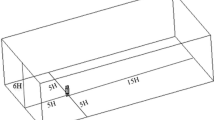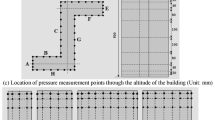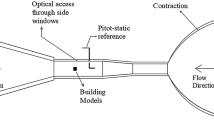Abstract
This study foresees the behavior of a ‘Z’ shaped in plan tall building under transient wind storms using unsteady Reynolds-averaged Navier Stokes (URANS) Computational Fluid Dynamics (CFD) technique. Numerical simulations are carried out using ANSYS - CFX, adopting length and velocity scales of 1:300 and 1:5, respectively. Surface streamlines are presented in the article to depict the wind flow characteristics and envisage the regions and nature of flow separations and vortex generations. The flow features also facilitate visualizing the wind pressure contours on building facets. The peak pressure coefficients concerning wind angles of 0° and 90° are presented to enable the cladding design of the building. Moreover, normalized wind pressure power spectra at three different sections along the altitude are offered for 0° to 150° wind at an interval of 30°. It is observed that towards the bottom portion of the building, the peak of the power spectra usually occurs in the low-frequency values. In contrast, at the top and main body of the building, the vortex shedding energy exaggerates at comparatively high reduced frequencies..
Similar content being viewed by others
References
Amin JA, Ahuja AK (2013) Effects of side ratio on wind-induced pressure distribution on rectangular buildings. Journal of Structures 2013:1–12, DOI: https://doi.org/10.1155/2013/176739
ANSYS 2019 R2 (2019) [SOFTWARE]
ASCE 7 - 22 (2022) ASCE/SEI 7-22 Minimum design loads for buildings and other structures. American Society of Civil Engineers, Reston, VI, USA
Bairagi AK, Dalui SK (2020) Forecasting of wind induced pressure on setback building using artificial neural network. Periodica Polytechnica Civil Engineering 64(3), DOI: https://doi.org/10.3311/PPci.15769
Balendra T, Anwar MP, Tey KL (2005) Direct measurement of wind-induced displacements in tall building models using laser positioning technique. Journal of Wind Engineering and Industrial Aerodynamics 93(5):399–412, DOI: https://doi.org/10.1016/j.jweia.2005.03.003
Bhatnagar NK, Gupta PK, Ahuja AK (2012) Wind pressure distribution on Low-Rise building with Saw-Tooth Roof. IV National Conference on Wind Engineering
Bhattacharyya B, Dalui SK, Ahuja AK (2014) Wind induced pressure on “E” plan shaped tall buildings. Jordan Journal of Civil Engineering 8(2)
Chakraborty S, Dalui SK, Ahuja AK (2014a) Experimental and numerical study of surface pressure on “+” plan shape tall building. Jordon Journal of Civil Engineering 8(3):251–262
Chakraborty S, Dalui SK, Ahuja AK (2014b) Wind load on irregular plan shaped tall building - A case study. Wind and Structures, An International Journal 19(1), DOI: https://doi.org/10.12989/was.2014.19.1.059
Dagnew AK, Bitsuamlak GT (2014) Computational evaluation of wind loads on a standard tall building using les. Wind and Structures, An International Journal 18(5), DOI: https://doi.org/10.12989/was.2014.18.5.567
Dalui SK (2008) Wind effects on tall buildings with peculiar shape. PhD, Indian Institute of Technology, Roorkee
Fu JY, Li QS, Wu JR, Xiao YQ, Song LL (2008) Field measurements of boundary layer wind characteristics and wind-induced responses of super-tall buildings. Journal of Wind Engineering and Industrial Aerodynamics 96(8–9):1332–1358, DOI: https://doi.org/10.1016/j.jweia.2008.03.004
Gomes MG, Moret Rodrigues A, Mendes P (2005) Experimental and numerical study of wind pressures on irregular-plan shapes. Journal of Wind Engineering and Industrial Aerodynamics 93(10), DOI: https://doi.org/10.1016/j.jweia.2005.08.008
Huang DM, Zhu LD, Chen W (2014) Power spectra of wind forces on a high-rise building with section varying along height. Wind and Structures 18(3):295–320, DOI: https://doi.org/10.12989/was.2014.18.3.295
Irwin PA (2008) Bluff body aerodynamics in wind engineering. Journal of Wind Engineering and Industrial Aerodynamics 96(6–7), DOI: https://doi.org/10.1016/j.jweia.2007.06.008
Irwin PA (2009) Wind engineering challenges of the new generation of super-tall buildings. Journal of Wind Engineering and Industrial Aerodynamics 97(7–8), DOI: https://doi.org/10.1016/j.jweia.2009.05.001
IS 875 (2015) IS 875: Code of practice for design loads (Other Than Earthquake) for building and structures - Part 3: Wind Loads. BIS, New Delhi 875(1)
Kareem A (1987) The effect of aerodynamic interference on the dynamic response of prismatic structures. Journal of Wind Engineering and Industrial Aerodynamics 25(3):365–372, DOI: https://doi.org/10.1016/0167-6105(87)90028-6
Kijewski T, Kareem A (1998) Dynamic wind effects: A comparative study of provisions in codes and standards with wind tunnel data. Wind and Structures, An International Journal 1(1), DOI: https://doi.org/10.12989/was.1998.1.1.077
Kim YM, You KP, Ko NH (2008) Across-wind responses of an aeroelastic tapered tall building. Journal of Wind Engineering and Industrial Aerodynamics 96(8–9), DOI: https://doi.org/10.1016/j.jweia.2008.02.038
Kushal PT, Ahuja AK, Chakrabarti A (2013) An experimental investigation of wind pressure developed in tall buildings for different plan shape. International Journal of Innovative Research & Studies 2(6)
Li Y, Tian X, Tee KF, Li QS, Li YG (2018) Aerodynamic treatments for reduction of wind loads on high-rise buildings. Journal of Wind Engineering and Industrial Aerodynamics 172, DOI: https://doi.org/10.1016/j.jweia.2017.11.006
Liang S, Li QS, Liu S, Zhang L, Gu M (2004) Torsional dynamic wind loads on rectangular tall buildings. Engineering Structures 26(1), DOI: https://doi.org/10.1016/j.engstruct.2003.09.004
Lin N, Letchford C, Tamura Y, Liang B, Nakamura O (2005) Characteristics of wind forces acting on tall buildings. Journal of Wind Engineering and Industrial Aerodynamics 93(3), DOI: https://doi.org/10.1016/j.jweia.2004.12.001
Mallick M, Mohanta A, Kumar A, Charan Patra K (2020) Prediction of wind-induced mean pressure coefficients using GMDH neural network. Journal of Aerospace Engineering 33(1), DOI: https://doi.org/10.1061/(ASCE)AS.1943-5525.0001101
Melbourne WH (1993) Turbulence and the leading edge phenomenon. Journal of Wind Engineering and Industrial Aerodynamics 49(1–3), DOI: https://doi.org/10.1016/0167-6105(93)90005-9
Meroney RN, B Bienkiewicz B (Eds.) (1996) Computational wind engineering 2. Elsevier, Colorado, USA
Muehleisen RT, Patrizi S (2013) A new parametric equation for the wind pressure coefficient for low-rise buildings. Energy and Buildings 57, DOI: https://doi.org/10.1016/j.enbuild.2012.10.051
Murakami S (1992) Computational wind engineering 1. Elsevier, Tokyo, Japan
Paul R, Dalui SK (2016) Wind effects on ‘Z’ plan-shaped tall building: A case study. International Journal of Advanced Structural Engineering 8(3), DOI: https://doi.org/10.1007/s40091-016-0134-9
Paul R, Dalui SK (2020) Prognosis of wind-tempted mean pressure coefficients of cross-shaped tall buildings using artificial neural network.
Periodica Polytechnica Civil Engineering 64(4), DOI: https://doi.org/10.3311/PPci.16311
Paul R, Dalui SK (2021a) Optimization of alongwind and crosswind force coefficients on a tall building with horizontal limbs using surrogate modeling. Structural Design of Tall and Special Buildings 30(4), DOI: https://doi.org/10.1002/tal.1830
Paul R, Dalui SK (2021b) Shape optimization to reduce wind pressure on the surfaces of a rectangular building with horizontal limbs. Periodica Polytechnica Civil Engineering 65(1), DOI: https://doi.org/10.3311/PPci.16888
Paul R, Dalui SK (2022a) Aerodynamic shape optimization of a high-rise rectangular building with wings. Wind and Structures, An International Journal 34(3), DOI: https://doi.org/10.12989/was.2022.34.3.259
Paul R, Dalui SK (2022b) Reduced frequency and power spectra of wind pressure of a tall building having “Z” shape in plan. Preprint
Revuz J, Hargreaves DM, Owen JS (2012) On the domain size for the steady-state CFD modelling of a tall building. Wind and Structures An International Journal 15(4), DOI: https://doi.org/10.12989/was.2012.15.4.313
Saathoff PJ, Melbourne WH (1989) The generation of peak pressures in separated/reattaching flows Journal of Wind Engineering and Industrial Aerodynamics 32(1–2), DOI: https://doi.org/10.1016/0167-6105(89)90023-8
Sanyal P, Dalui SK (2018) Effects of courtyard and opening on a rectangular plan shaped tall building under wind load. International Journal of Advanced Structural Engineering 10(2), DOI: https://doi.org/10.1007/s40091-018-0190-4
Standards Australia International, Standards New Zealand (2011) Structural design actions. Part 2, Wind actions. As/Nzs 2011(1170)2:2011
Stathopoulos T, Saathoff P (1991) Wind pressure on roofs of various geometries. Journal of Wind Engineering and Industrial Aerodynamics 38(2–3), DOI: https://doi.org/10.1016/0167-6105(91)90047-Z
Sun FJ, Gu M (2014) A numerical solution to fluid-structure interaction of membrane structures under wind action. Wind and Structures, An International Journal 19(1), DOI: https://doi.org/10.12989/was.2014.19.1.035
Surry D, Djakovich D (1995) Fluctuating pressures on models of tall buildings. Journal of Wind Engineering and Industrial Aerodynamics 58(1–2), DOI: https://doi.org/10.1016/0167-6105(95)00015-J
Tse KT, Hitchcock PA, Kwok KCS, Thepmongkorn S, Chan CM (2009) Economic perspectives of aerodynamic treatments of square tall buildings. Journal of Wind Engineering and Industrial Aerodynamics 97(9–10), DOI: https://doi.org/10.1016/j.jweia.2009.07.005
Verma SK, Ahuja AK, Pandey AD (2013) Effects of wind incidence angle on wind pressure distribution on square pan tall buildings. Journal of Academic Industrial Research 1(12):747–752
Zhang A, Gu M (2008) Wind tunnel tests and numerical simulations of wind pressures on buildings in staggered arrangement. Journal of Wind Engineering and Industrial Aerodynamics 96(10–11), DOI: https://doi.org/10.1016/j.jweia.2008.02.013
Zhi LH, Chen B, Fang MX (2015) Wind load estimation of super-tall buildings based on response data. Structural Engineering and Mechanics 56(4), DOI: https://doi.org/10.12989/sem.2015.56.4.625
Acknowledgments
The authors acknowledge Research Square for posting a preprint of the manuscript with DOI: https://doi.org/10.21203/rs3.rs-1618818/v1_(Paul and Dalui, 2022b).
Author information
Authors and Affiliations
Corresponding author
Rights and permissions
About this article
Cite this article
Paul, R., Dalui, S.K. Pressure Power Spectra of a ‘Z’ Shaped in Plan Tall Building under Transient Wind Environment. KSCE J Civ Eng 28, 1916–1927 (2024). https://doi.org/10.1007/s12205-024-1255-5
Received:
Revised:
Accepted:
Published:
Issue Date:
DOI: https://doi.org/10.1007/s12205-024-1255-5




